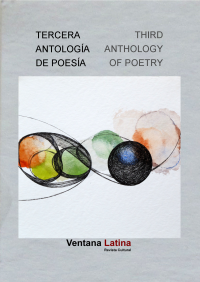The Work of Fire, by Juan José Burzi
Translated by James Johnson
It all started with a scene that came to dominate his dreams through force of repetition. In it, he was in his studio, painting at his easel. Beyond him, on a raised platform, there was a naked woman. At this point, the dream stops for a moment, before her body undergoes a horrifyingly quick mutation. Her skin darkens and peels away in great shreds. Where her withered skin has fallen away, he glimpses quivering, palpitating flesh. He carries on with his work, oblivious to events around him.
This scene was always exactly the same, and Mayer could never understand where it came from or where it would take him. Sometimes, barely awake, he had vivid recollections of snippets of the dream – him, painting, from behind; the woman’s body decomposing; the woman, still unharmed… – and sometimes he remembered everything perfectly, like an irrevocable sequence whose illusion would shatter as soon as he put brush to canvas.
At different stages of his career he had painted portraits of the deformed and the peculiar. He felt attracted to the erroneous, to nature’s mistakes. He was inspired by everything that was rejected by the mainstream. That’s why, when after two months the dream had left him obsessed, he understood that he just had to do something.
He searched tirelessly until he found the right woman for his latest project: Misako, a Japanese model who, in a fire, had suffered nearly fifty percent burns.
He knows that her hands are the starting point for the first painting. He takes her left, the hand the fire left maimed and useless. Her index and middle fingers were fused together when her flesh melted. She is without her pinky, and the remaining two are coiled in permanent tension like the two that are joined. The hand is different – almost poreless – to the touch. Once again, he notices the parts where the skin shines more darkly than in the healthy sections. Her scars clump in a chaotic thicket, stretching and contracting her skin capriciously.
In addition to her hand, the majority of her torso and left arm and leg are also disfigured. Unclothing her, he gets a better look at her burnt leg. Her foot sits strangely, and her pinky toe seems to have withered downwards in the heat.
Then he fixes his gaze on her head. Part of her skull is fully exposed. In other areas of her face, her scars bleed in to one another, knotting like contracted nerves one on top of another to form a grotesque landscape. The corner of her mouth is twisted upwards. Her expressionless left eye looks ready to fall from her head, and her eyelid is a lashless layer of wrinkled skin.
She looks like an angel seen from hell.
He is seventy five, without relatives, and shut away in his house at his own decision, with only the works that he decided not to sell for company: the dwarf couple, two portraits of those Siamese teens, and sketches of the remains of the Solaris sect suicide pact, taken at the morgue.
His paintings are hung in a special room where the afternoon sun lights up the walls, imbuing them with a yellowish, washed out light. Every now and then, he likes to sit in a corner and observe the imperceptible changes that this light casts on the canvases.
Her naked body against the white, stripped of all circumstance and nuance, prevails over the void. It is the very embodiment of unity – the point of departure and the finishing line. A tiny crack where the fragility and error of years of aesthetic judgments can be glimpsed. And this unabashed body is covered in scarred and arid wounds, like footprints left by some careless god.
Her eyes reflect the lights of two different worlds. Those which lit up the days of man, and those which, until that moment, no modern man had ever glimpsed; the same lights endured by Medusa, and that somebody dared to look at only obliquely, for staring them straight down meant turning into stone, giving oneself over to a state of eternal and muted madness. Between her healthy breast and the other, purple and scarred, her incomplete and charred hand pretends to rest. But it is condemned never to find repose again.
He washes his body with soap beneath the shower’s warm water. As he leans forward to lather up his left leg he sees a wound running up one side of his tibia. He looks at it closely, touches it, but feels no pain. It is a burn that has already scarred – a burn he never suffered. Its dun colour and unevenness to the touch are just like the burns that he is painting.
There is no sadness greater than that to be discovered at midday. That arbitrary idea is a recurring theme of his musings. A blunted, mute and monotonous midday, like those he had known in the provincial town of his childhood. The town to which he returns more than half a century later, at least in his mind, from his ramshackle house, also dulled and monotonous. The cycles of life are still full of poetic justice, he thinks.
Mayer embarks on the second painting without making the slightest effort to empathize with Misako. It’s the way he always worked. The peculiarities of those he painted only interested him insofar as he could capture them on the canvas, and no more. But he runs into a problem. Each time he looks at Misako, his thoughts drift back to the mark on his leg.
Misako never changes her demeanour. She behaves with a careful obedience, and Mayer can never quite decide whether this is an example of the subordination often attributed to Asian women or if, on the contrary, her distance and placid disposition are not the manifestations of some irony that he cannot grasp.
Sometimes, her muteness even pricks him with fear. It was a feeling that had begun to arise in recent nights as he examined his body, unable to shake the image of Misako naked, her healthy eye shaped like an almond and her other, lidless, staring straight at him.
One afternoon, at the session’s conclusion, Misako emerges fully dressed from behind the screen and walks over to the easel, where the paintings are sitting. He has captured her, body and soul, in these canvases. They transmit the same power as her burned body. She leans forward a little and he notices, by an almost imperceptible movement of her nostrils, that she is inhaling the aroma of the still fresh paint. She stays in this position for a few seconds, then goes to the furthest easel. Without asking permission, she slides her healthy hand over the canvas like a blind person reading brail.
The scars had taken over his entire left arm. He had been checking them more diligently than at first, especially when he saw the first marks on that part of his body. In a matter of days, not even a week since he first discovered them, these marks gave way to the first scars of the unflinching fire consuming him from inside. His mutation appeared to be speeding up.
Mayer also noticed a dull pain in his scarred leg. During their last session, he had started to feel it in his arm too.
Despite these developments, he refused to call a doctor or reduce his workload. He didn’t call the doctor because he had a feeling that his case would leave science without answers. His resemblance to the model reached such a point that he too began to walk with a slight limp on his left side. The last time he looked at his foot, he noticed that his pinky toe was beginning to coil on itself like a snail’s shell. What could a doctor possibly tell him faced with that type of coincidence?
Mayer decides to wrap his hand in bandages after noticing how the cashier looked at him in the supermarket. She fixed her gaze on his hand’s arid and devastated skin. While paying, he felt her looking at marks already appearing on his neck and part of his face. When these eventually developed into scars, there would be no way for him to hide them.
Misako makes no allusion to his hand. He does, however, feel her gaze lingering over the marks on his face, just like the cashier’s. Mayer last saw himself in the mirror the previous night, and as he follows her into the studio he wonders whether the scars will have already begun to show.
Walking behind Misako, he notices another thing that unseats him; he is hobbling worse than the model. She maintains the discrete irregularity that he always saw in her, but his limp is more pronounced. With this he confirms that although his scars are identical to Misako’s in appearance, they have a different effect on him for some reason. The proof is easy to see; while Misako can remain in one position for over an hour, stretching only briefly from time to time, he is incapable of standing for the same duration.
One night, he feels a severe, constant stabbing pain in his leg. He tries to hold himself up against the wall, but it doesn’t stop him falling.
He makes multiple attempts to stop himself, the last ones with no hope of regaining his balance. He rests on the floor, half lying down, to regroup. He has lost control of his left leg, which seems to have fallen asleep.
From this position, he appreciates how the shimmering moon bathes the room as it spills in through the skylight.
He also wonders about Misako. Who is she, really? What is she hoping for from this job?
At night, leaning on the crutch on which he is now totally reliant, Mayer goes to the bathroom. As he passes the mirror he cannot resist the temptation to look at himself, even just fleetingly. He is petrified by what he sees, and only keeps his balance by desperately grasping his crutch on one side and the basin on the other. At worst, he expected to see himself with the same scars as Misako, but they are even more widespread on his body. His chin is covered in them, and has lost the thick beard that populated the rest of his face. The same is happening to the left and the middle. His grey hair now only clings to the right of his scalp, and his lip, totally blackened, is twisted into a bitter grimace.
At some point shortly after starting the fourth painting, he loses the use of his right leg and depends purely and exclusively on two crutches to move around. Misako remains impassive before Mayer’s new condition, just as she did when he started using the first crutch or when she saw the scars.
At about the same time, purplish blotches appear on his right hand, the one he uses to paint. Now and then, his pulse flutters and he’s unable to bring it under control. He grows desperate at this revelation, a feeling intensified when he starts to have problems with his vision. He sees everything through a treacherous mist, and starts to doubt his choice of colours.
Given the tiny lapse between the appearance of the blotches and the effects of the burns, he decides to go back to working for stretches of between two and three hours. When exhaustion forces him to stop, he makes a gesture to indicate that Misako may be at ease, and sits in his chair, looking out into the void, as though wishing he could cut through the fog that has settled between himself and the model. For her part, Misako does not rest, perhaps aided by the position she has chosen or perhaps as a way of proving her resolution that they would finish the portraits.
As he is just about to finish the fourth portrait, his worst fear comes true: a ferocious pang of pain drags his right hand downwards; forcing him to trace a brown line over the half of the body he had already painted. He drops his paintbrush and shakes his hand out, as though this could help him expel the ill that is invading him. Very shortly afterwards, his hand contracts steadily, assuming the shape of an inverted claw. Scar tissue packs tightly over his tendons, and he wonders exactly when these scars must have appeared.
Utterly defeated, he is bent double over his own lap, as though wanting to melt down inside himself.
Mayer has no idea how to pick up his paintbrushes. The fingers of his right hand have set into their crookedness, and are covered in scars.
Misako props him up in front of the fourth painting, which Mayer can hardly see with his vision getting progressively more clouded. She puts a brush in his hand, and fastens it in position with tape. Among the shadows dancing before his failing eyes, he can make out the concentrated expression on her face.
She climbs onto the platform and assumes the pose that she had chosen days before. Mayer can barely see her; his eyesight is worse than he thought. He starts painting again in silence, using his memories of the previous sessions as a guide.
Though he is practically blind, out of habit he turns his head slightly towards where Misako is lying. He is as attracted by her skin as he was the first time he saw her. And he continues working like that for over an hour, until he stops suddenly. He knows he is finished.
He lets his arm fall on his legs. Exhausted by pain, the suffering that he had put out of his mind during that last session returns to caress his entire body. Mayer cries out – a broken and resigned scream. He immediately feels the presence of Misako at his side. She doesn’t say a word. He hears movements close by. She is moving things around. He senses her moving past him, doing something with the easel. Hearing her bare feet moving away, he stretches out his hand in a last ditch effort. Where there should have been the canvas there is now nothing. She is stealing the paintings.
Next, the studio door closes, and he imagines himself left to his fate, to die alone, haunted by the darkness. He is not afraid, and even before he hears the door opening again he knows that Misako is not going to leave him. She is once again at his side and carries on moving things, somewhat hastily. The pattern of the noise settles around him in a circle – Mayer deduces that she is surrounding him with objects.
As the noises finish, she places a hand on his shoulder, and it is then, with that gesture so simple and so restrained, that Mayer realizes that the paintings are safe in the front part of the house.
The noise of the panting flames blends with the heady odours of burning paint tins. Misako doesn’t move her hand from his shoulder even for a moment.
Mayer penetrates the darkness in his eyes for just a few seconds, time enough to see the walls of fire surrounding them and to discover in their flames a sweetness that he never would have imagined.
Read the interview with Juan José Burzi here (in Spanish).








 Copyright © 2024 Company no. 6720498 10 Kingsgate Place, London NW6 4TA, United Kingdom Tel: 020 7372 8653
Copyright © 2024 Company no. 6720498 10 Kingsgate Place, London NW6 4TA, United Kingdom Tel: 020 7372 8653